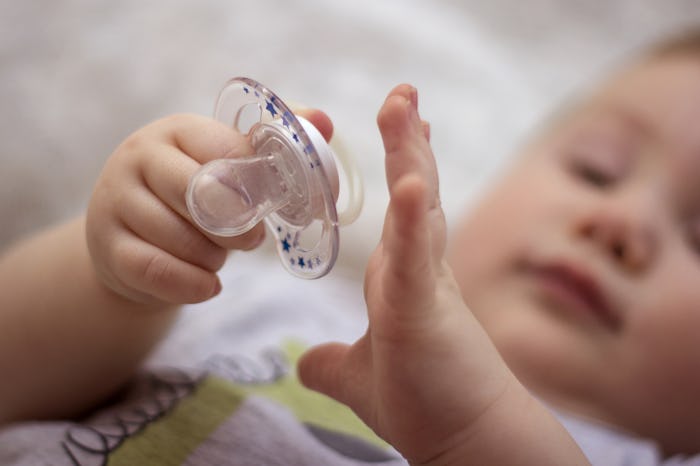Life

Here's How To Get Your Baby To Take A Pacifier (& Give Yourself A Break)
When I created a registry for my first baby, I added pacifiers and paci clips, not even thinking about whether or not my baby would want a pacifier; I just assumed she would, like all the babies I saw in stores and restaurants happily sucking away. But once she was born, the matter of pacis, like many parenting topics, turned out to be more complicated in practice than it had seemed in theory. If your child doesn't automatically accept this soothing tool, you have to figure out how to get your baby to take a pacifier. Turns out, there are a variety of approaches you can take depending on your child's temperament and whether they are used to breastfeeding, a bottle, or both.
Pediatrician Harvey Karp, author of The Happiest Baby On The Block, includes sucking in his "5 Ss" approach to soothing fussy babies. He also noted that pacifiers can be difficult because babies either love or hate them. "If your baby resists taking the pacifier, try offering it when she relaxes, towards the end of a feed," wrote Karp on his website. Both breastfeeding and bottle-feeding parents can try this approach. For paci-resistant babies who primarily or exclusively breastfeed, Karp suggested the following "trick:"
"Toward the end of a nursing — when Aidan relaxed and his sucking slowed — Denise tried this trick; removing her breast and immediately sliding in the paci (like a classic “bait-and-switch”). When it was snugly in his mouth, she would wait for him to suck on it… then she would pull it back a smidge, like testing if a fish is on the line. He responded by sucking harder."
Some babies are more genetically prone to sucking than others, Karp explained, so sometimes a little practice is all it takes for a baby to get the hang of the paci.
Timing is another important factor in getting your baby to take a pacifier. If you're breastfeeding, experts recommend waiting until baby has gotten the hang of it before introducing any artificial nipples, whether a pacifier or bottle. How long should you wait? Anywhere from three to six weeks depending on how quickly your nursling takes to the breast. Some babies take up breastfeeding right away without issues, while others may need the help of a lactation consultant.
Offering your baby a pacifier too early can lead to "nipple confusion" because the mechanics of nursing versus sucking on a bottle or pacifier are different. As AskDrSears.com explained, "To get milk from the breast, baby must coordinate tongue and jaw movements in a sucking motion that's unique to breastfeeding ... Babies suck from a bottle entirely differently. Thanks to gravity, milk flows from a bottle so easily that baby does not have to suck 'correctly' to get milk." This is why some breastfed babies reject pacifiers entirely and why introducing a pacifier or bottle too early can create challenges for successful breastfeeding.
Besides timing it correctly and trying Karp's "bait and switch" approach, dipping the pacifier in breast milk or formula before offering it to your baby may make the soother more palatable. Your child may also be more accepting of the pacifier if it's offered by anyone except Mom. If you're breastfeeding, your baby associates you with that kind of comfort and may not want to take anything else. Try having your partner or another caregiver offer the pacifier instead.
Personally, neither of my kids would take a pacifier when they were babies. After trying different approaches, I gave up and found other ways to soothe them. Talk to your pediatrician if you have concerns about pacifiers or finding ways to soothe a fussy baby. Every child is different, so just because every other baby on Earth seems to have a binky, it doesn't mean there's anything wrong if yours spits it out.
Check out Romper's new video series, Romper's Doula Diaries:
Watch full episodes of Romper's Doula Diaries on Facebook Watch.